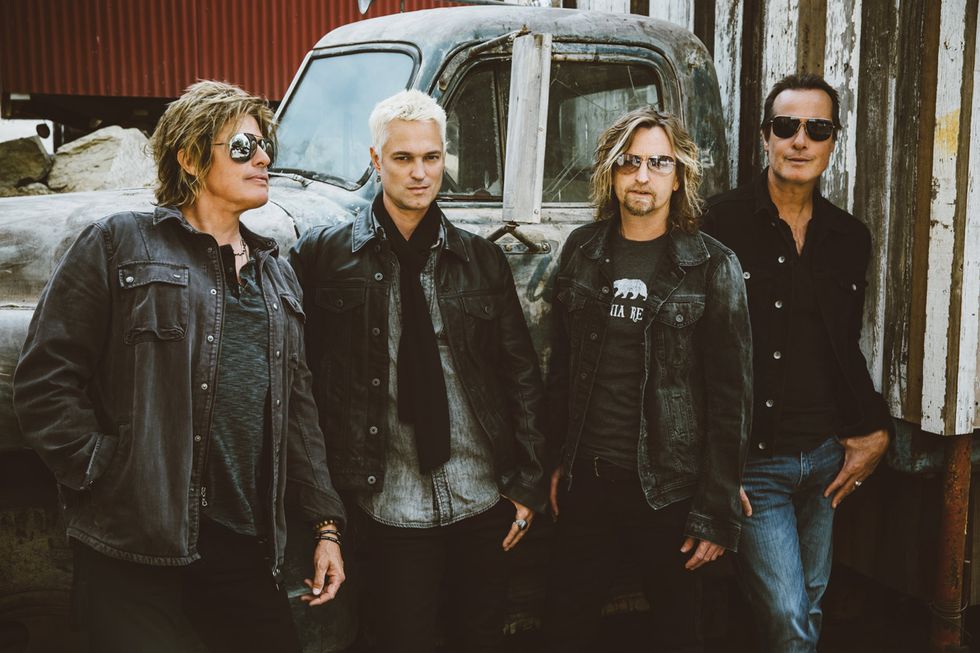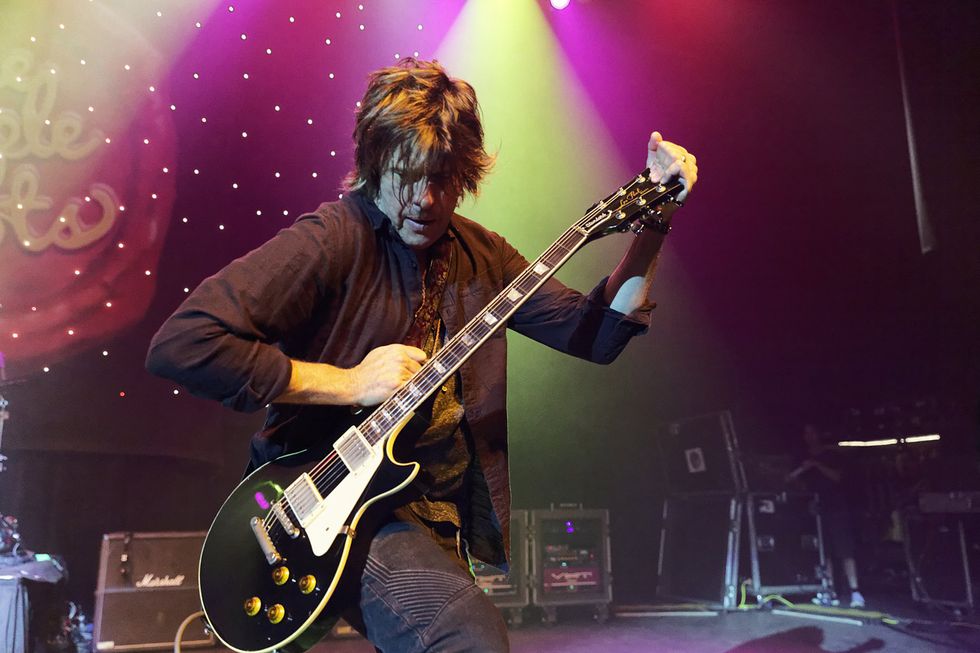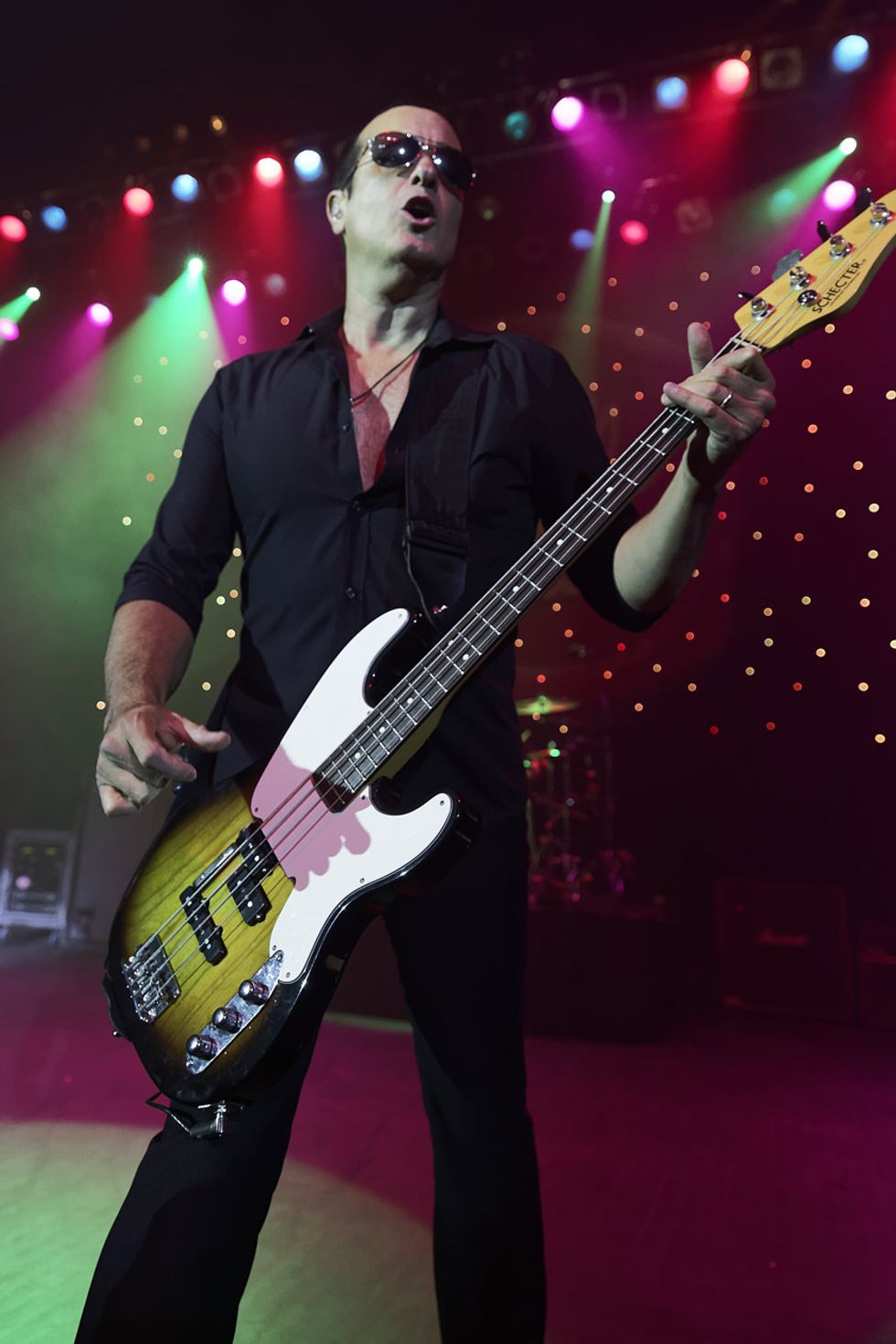Laughter is perhaps the most auspicious way to start an interview with Dean and Robert DeLeo of Stone Temple Pilots. The deaths of their two former lead singers, Scott Weiland and Chester Bennington, who passed in 2015 and 2017, respectively, has been casting a bit of a dark cloud over their every move. But Dean quickly sets an amiable tone for our conversation with a quip he nicked from Cameron Crowe’s liner notes in Led Zeppelin’s 1990 Boxed Set. Upon introducing myself and offering my credentials, he responds with, “I don’t come to you with my problems.” Laughter ensues and the ice is broken.
The line comes from an interaction Crowe witnessed as a young man when he was a journalist on tour with Led Zeppelin. He saw Peter Grant walk up to Bob Dylan and say, “Hi, I’m Peter Grant. I manage Led Zeppelin.” And Dylan responded, “I don’t come to you with my problems.” Dean is clearly bemused by the set up: “How great is that? I use that line for everything and I crack up every time.”
Starting an interview about Stone Temple Pilots’ self-titled new album in this way is pleasantly disarming and illuminates the immense modesty the DeLeo brothers appear to share. It’s a welcome character trait from two bona fide rock stars that literally reshaped the musical landscape in the early ’90s as part of the grunge movement with albums like Core and Purple.
In the ensuing years, STP evolved into one of the most musically diverse alternative-rock bands, growing sonically on albums like Tiny Music… Songs from the Vatican Gift Shop and No. 4 by interweaving elements of classic rock, glam, psychedelia, and Motown. The only obstacle that seemed to prevent them from rising to even greater heights was Weiland’s well-documented battle with drug addiction and his resulting departures from the band.
Despite those troubles, Dean and Robert, along with STP drummer Eric Kretz, never appeared to wallow in self-pity, and they certainly don’t seem to dwell on the past—especially when it comes to music. Instead, they’ve opted to escape the tumult by entrenching themselves even more deeply into their music via offshoot projects like Talk Show and Army of Anyone, or beginning the monumental task of rebranding STP with a new front man—first with late Linkin Park vocalist Chester Bennington and now with Jeff Gutt. They’ve even explored side gigs along the way, performing with Joe Walsh, Hollywood Vampires, Kings of Chaos, Delta Deep, and others. No matter how challenging the circumstances, the DeLeo brothers always seem to stay above the fray by seeking out a good tune … and perhaps a good laugh.
Which isn’t to say they are indifferent to the suicides (accidental or otherwise) of their two former front men. There’s obviously a tremendous amount of reverence for the band’s legacy and the people they’ve collaborated with. They just aren’t overly nostalgic about it. In theory, it would’ve been economically viable for them to hire a Scott Weiland clone, forego making a new album, and go out on tour exploiting STP’s past. They sure have enough hit songs to ride on. “Plush,” “Interstate Love Song,” “Vasoline,” and four others have reached the apex of Billboard’s Mainstream Rock chart, and 17 more have wedged in its Top 20. But the DeLeos aren’t inclined to rest on their laurels. They are eminently motivated by what they both call the “power of song,” and it is the pursuit of songcraft, and making new music, that ignites their drive. And now, after a year-long online search for a new singer, from which they landed Gutt (a former contestant on The X Factor), it seems STP has firmly embraced the future and delivered what’s arguably their best album in years.
Stone Temple Pilots is an album of immense emotional depth and musical breadth. There are the familiar artistic components that have come to define STP’s sonic blueprint, like Dean’s eclectic guitar tones and stylistic choices, and Robert’s gritty, Motown-inspired bass lines, but the wistfulness of “The Art of Letting Go,” “Thought She’d Be Mine,” and “Finest Hour” demonstrate a peak level of songwriting. The hooks seem smarter than ever, the performances more sensitive and nuanced, and the production value just a smidge tighter than their previous albums.

STP produced their latest album and credits the band’s early producer, Brendan O’Brien, with teaching them the secrets of the studio. “Brendan worked fast and efficient and he got the best out of us, quickly. That’s how we learned to make records,” says Dean.
Gutt is a singer of inspired rhythmic phrasing and melodic sensibility, and he has clearly taken the baton and ran with it. He doesn’t seem intimidated by the role he’s stepping into, and it’s clear that the DeLeos didn’t simply want a singer who could only cover the back catalog. The real criterion for their new singer, they explain, was the ability to write at a very proficient level. “He’s really good,” says Dean. “We’ve been very fortunate to be able to write at a certain level of musicianship in this band. Writing music with Scott was just incredible—so fulfilling, what he brought to a song—and it’s the same with Jeff.”
PG caught up with Dean and Robert as they were preparing for Gutt’s inaugural U.S. tour with STP. This summer they embark on the Revolution 3 Tour with fellow ’90s luminaries, Bush and the Cult. The DeLeos are humble, gracious, humorous, and willing to divulge intimate details about the instruments, live rigs, recording techniques, and songwriting and arranging ethos that keep STP humming.
What was the writing process like for Stone Temple Pilots? Did you write with any of the potential singers?
Robert DeLeo: There were a few songs that were around back when Chester left the band, so we put it all down because we knew we had a task ahead of us—getting a new singer. But a lot of these songs really came from the spark of having Jeff’s presence there and getting together in the studio and speaking the conversation of songwriting. I think one of the most important things for finding a new singer was someone who could move forward and write, and Jeff really applied his art to what we were doing.
Did you share files or were you literally writing together, in the studio?
Dean DeLeo: A lot of the stuff was pre-written. Robert would come in with a song completed or I would come in with a song completed. But the song that was written from the ground up, in the moment, and sounds like it would be the last song on the record to be written that way, was “The Art of Letting Go.” We were at Eric’s recording vocals, and I picked up a guitar and that song literally came out in minutes. Jeff heard what I was playing and came in the room and immediately started singing what you hear. I even think he used the “art of letting go” lyric right away—it was immediate. The song was based around that lyric. That is the song that really solidified Jeff’s talent.
Dean DeLeo bends a note the hard way on one of his Gibson Les Paul Standards during a 2015 show at San Francisco’s the Fillmore. DeLeo’s tones come from a fleet of five Pauls, two Paul Reed Smiths, and a group of single-coils that includes T- and S-style Nelson models and a vintage Danelectro. Photo by Ken Settle
It’s amazing how well you two brothers complement each other, weaving in and out of each other’s parts in songs like “Guilty” and “Just a Little Lie.”
Robert: Dean and I complementing one other is really a mutual respect for each other’s talents and playing. I think it’s a matter of when to say something and when not to say something. That comes from years and years of playing together and just trying to put our best foot forward, artistically, with each other.
You’re both able to be interesting, musically and melodically, without ever getting in the way of the vocal melody, like in “Thought She’d Be Mine.”
Dean: Thank you. That is one of the greatest compliments I’ve ever had. I appreciate that because we can easily get in our own way. I think you really need to let the song dictate what it wants or what it needs. It’ll tell you. You just have to listen.
You strike a fine balance between riff-oriented ideas and letting the songs breathe— utilizing space, chord inversions, and chord changes—within the context of the same song, like “Six Eight” or “Never Enough,” for example.
Dean: It’s a concerted effort. What is the song telling you it needs? Once I become willful, in anything I do, once I put my mitts in it, I can fuck it up really quickly. You really have to listen to what the song wants to do. And there are many times where it’s like, “I’m hearing this part here; let me try this.” And I lay it down and it’s played well, there’s a nice tone, but then I’m like, “It’s better without it.” That’s where you really need to put your ego aside, put your ability aside, and ask, “What is the song telling you it needs?”
its own story.” —Dean DeLeo
Dean, do you approach your guitar solos the same way?
Dean: Yeah. Absolutely. And I also want to go very wide. Not only do I not want to repeat what I did on previous records, but I also don’t want to repeat myself on this record. So, the solos are very different from song to song. And not just in tonality, but an entirely different approach—from “Just a Little Lie” to “The Art of Letting Go” to “Reds & Blues.” One of the most beautiful things about guitar is, I have so many different instruments to pick from—from a single-coil Tele or Danelectro or a Strat to a Les Paul with a PAF. Each one tells its own story.
Do you work out your solos in advance or are they improvised?
Dean: If you go back to [2001’s] Shangri-La Dee Da, I approached those solos very differently. I didn’t even pick up a guitar. I didn’t want to get into some kind of pentatonic mode and play a guitar solo per se, so I sat there with the song and I had a little recorder and sang my solos. Then I transposed them to guitar. That’s why the solos on that record are a little more melodic. This record was different. I didn’t have anything really predetermined. I waited to see where Jeff was going to leave off. I’m sort of playing off his vocals.
When tracking, do you go for a basic rhythm sound for the whole record or do you use different sounds from song to song?
Dean: I kind of know, once the song is at its inception, where I want it to go sonically. It’s just about chasing that tone. For me, it’s about getting what’s going on in my bean [head] and making that come out of the speakers. That’s the name of the game. And sometimes it works and comes along quickly—and it’s nice when that happens. But sometimes you stumble upon a different tone, and you’re like, “I kind of like that better.” It’s nice to have the ability to not chase your tail.

Guitars
Live
Five ’88 Gibson Les Paul Standards
Two ’60s Fender Telecasters
Two Nelson Guitarwerks T-Classics
Two PRS McCarty Semi-Hollows (with a piezo pickup for acoustic sounds)
’56 Danelectro U2 with lipstick pickups
Two-pickup ’60s Danelectro double-cutaway
Fender ’60s Telecaster with Bigsby
Nelson S-style guitar
’60s Kay
’60s Kustom
’60s Gretsch Country Gentleman
’50 Gibson J-50
’45 Martin 0-18
Amps (live)
Demeter TGP-3 Guitar Pre-Amp
VHT 2100 Classic power amp with EL-34 tubes
Vox AC30 with Celestion Alnico Blues
Two Marshall 4x12 slant cabinets with Celestion Vintage 30s
Effects (live)
Rocktron Intelliverb
MXR MC406 CAE Buffer
Dunlop GCB95F Cry Baby Classic Wah
Boss CE-1 Chorus Ensemble
SIB Varidrive Tube Overdrive Distortion
RJM Music Mastermind GT/10 MIDI Controller
Strings and Picks
Dunlop DESBN1046 Super Bright strings (.010–.046)
Dunlop Chrome Guitar Slide 318
Dunlop Delrin 500 (heavy pick)
Do either of you have any formal education as a musician?
Robert: None at all. Just being a good listener is an education. Being the youngest of a big family back in the early ’70s, I was very curious about records and I remember some of the first records that I picked up and had the pleasure of listening to were by the Beatles and the Beach Boys. I heard that music back then and it was like the bell ringing. I was so amazed. And I had a very good understanding, at 5 or 6 years old, of rhythm and bass playing and hooks and lines and flavors and arrangements. It really caught, I would say, my ear, but it really caught my soul.
Robert, your bass lines can often be very active, but they only ever seem to enhance the song or melody, like in “Reds & Blues.”
Robert: That goes back to most of the stuff that [Motown bassist] James Jamerson was doing on pop songs. I’m just amazed by what he got away with. If you listen to “It’s a Shame” by the Spinners, I mean, that just blows me away. It’s one of my favorite bass lines. Or “Ain’t Nothing Like the Real Thing” [by Marvin Gaye & Tammi Terrell]. Wow! He’s the guy that set the tone for everyone else. He’s the highest up there for me.
I definitely hear his influence in your playing—especially in “Finest Hour.”
Robert: It’s the breath in between the notes, not actually what you’re playing, to me. It’s the breathing of the line that gives it its breadth and that’s what always amazed me—the spaces in between and what people did with that.
Do you ever play with a pick or is it strictly fingerstyle?
Robert: I’ve been doing some outside projects, and one of them is with Matt Sorum from Guns N’ Roses, who has a project called Kings of Chaos. We did some stuff with Billy Idol and that material is all strictly pick. I owe Steve Stevens for saying, “Hey man, can you play that with a pick?” I was like, “I don’t know if I can, but I’ll try.” I really wrapped my head around it. It has a certain kind of percussive, aggressive attack to it that really fits those songs. I had a blast doing it.
Are there any pick players that ever stood out to you when you were growing up?
Robert: There are two, and they’re completely different from each other. One is Chris Squire. I am constantly amazed by what he did with not only his playing, but also his tone. And then, Graham Maby’s playing really stood out to me on the first two Joe Jackson records [Look Sharp! and I’m the Man]. “Sunday Papers” is some good, clever bass playing.
I read somewhere that your goal, as a bassist, has been to combine the feel of James Jamerson with the sound of John Entwistle. I think you achieved that on this album—especially on songs like “Roll Me Under.” What’s your secret?
Robert: With all the records we’ve ever made, I’ve pretty much used the same thing. In the beginning I had a ’61 Fender Bassman head—it was actually Dean’s—with a special-order Bassman cab that had the original JBL 15" in it. Unfortunately, it crapped out after we did the High Rise EP [in 2013] with Chester. So, I was panicking on what to do. I was so used to using that. So, I pulled out a ’67 Ampeg B-15N I own and realized I had more low-end and a different midrange from the Bassman. I liked what it was doing, so I put a vintage Neumann U67 on it and used that.
Although Rob DeLeo is playing a Schecter P-style here, his current stage basses are made by STP guitar tech Bruce Nelson and include a combo of Lollar P and J pickups with individual volume controls and one master tone. Bodies are 1-piece alder with a nitrocellulose lacquer finish. Photo by Ken Settle
Do you ever record multiple tracks for bass or is it just the one track?
Robert: There are three bass tracks on this record: the B-15N, then, on another track, I used the Little Labs Redeye direct box, and I have an Ampeg VT-22, which is essentially a V-4 in combo form. It’s 100 watts. I take the speaker out of that and power the head into a 1970 Marshall 8x10. That’s the growl that you hear. The midrange from the switches on the VT-22 gives you this notched kind of thing. Back in the day, during Tiny Music…, No. 4, and Shangri-La Dee Da, I was using the Bassman with the 8x10, and I was putting a wah in there and cocking it, which you can really hear in the bass tone of “Down” [from No. 4]. That’s what I’m doing now, but with the VT-22 through the 8x10.
What basses did you use on this album?
Robert: I got a chance to use a lot of my basses. I have a very nice vintage collection that I got from a gentleman who’d been storing basses away for 30 years, and some of them hadn’t been opened in 50 years [laughs]. Some are literally mint from the ’50s, ’60s, and ’70s. They don’t leave my house.
Are you cautious about dinging vintage mint condition basses?
Robert: I dare not sweat on them [laughs]. I’m going to invent something new, like the “arm sock” for when you’re playing your vintage basses and you don’t want to scratch them or sweat on them. What was that thing you put on, like a robe, and you watch TV?
—Robert DeLeo
Snuggies?
Robert: Snuggies! Yeah! I’m going to come up with a bass Snuggie. You put that on your arm in case you don’t want to sweat on your vintage instrument [laughs].
What basses are you playing live?
Robert: Dean’s tech and our good friend, Bruce Nelson, is a very, very proficient luthier. We just recently played with Joe Perry and Joe’s been playing some of Bruce’s guitars. I had him build me a couple of basses and they’re just amazing. They feel so comfortable, and he’s building them from scratch. So, I’m using Nelson basses now.
How did you meet Bruce?
Dean: I went to Bruce’s house only because he was setting up a friend’s guitars. Bruce answered the door and within 10 seconds I was like, “Oh my god, I love this guy.” He was so kind and knowledgeable. I was just about to go on tour with Joe Walsh and I said to him, “Hey man, do you ever go on the road? Robert and I are going out with Joe Walsh for a few weeks. Would you want to do it?” And he was like, “What are the dates?” He was working for Tom Anderson at the time, building guitars. So, I gave him the dates and he goes, “Ironically, your dates line up with my vacation.” We’ve been pals ever since. He’s first and foremost a beautiful human being. He’s built me four guitars: three Teles and a Strat. This one Tele has Firebird pickups in it. It’s an incredible guitar.

Basses (live)
Bruce Nelson-built Nelson Guitarwerks hybrid P/J-style basses (These include Lollar P and J pickups with individual volume controls and one master tone. Bodies are 1-piece alder with a nitrocellulose lacquer finish. They have a custom 12-gauge, steel-string, through-body bridge with 3/8" brass saddles and a 1/2" thick recessed steel string block. Nelson’s neck plates are 12-gauge steel with six neck screws, and the necks are quarter-sawn torrified maple with Indian rosewood fretboards, block inlays, and binding. The frets are stainless steel, the nuts are brass, and they employ Hipshot Bass Xtenders.)
(Studio for Stone Temple Pilots)
1965 Fender P Bass with padauk fretboard on “Middle of Nowhere,” “Just a Little Lie,” “Six Eight,” “Roll Me Under,” “Finest Hour,” “Good Shoes,” “Guilty” (with Electro-Harmonix Bass Micro Synth), and “Meadow” (with Maestro BB-1 Bass Brassmaster fuzz)
1976 Rickenbacker 4001 on “Thought She’d Be Mine”
1971 Rickenbacker 4001 fireglo with flatwounds on “Never Enough”
1972 Fender J bass on “The Art of Letting Go”
1974 Fender Telecaster Bass on “Reds & Blues”
Amps
QSC PLX1602 2-channel, 1600-watt power amp (live)
Two Ampeg SVT-810E 800-watt extension cabs (live)
1967 Ampeg B-15N (studio)
Ampeg VT-22 (studio)
Effects
Line 6 Bass POD XT Pro amp modeler
Furman PL-8 Power Conditioner
Shure ULXD4D Dual Channel Digital Wireless Receiver
Strings and Picks
D’Addario EXL160 Nickel Wound Medium (.050–.105)
How important is your tech to your performance each night?
Dean: We’re so in tune with one another. And he knows my guitars. He knows that on the black Les Paul he has to flatten the G string just a hair, and on one particular Tele I need to have the B string a little sharp because it’s tuned to open D minor. He knows the idiosyncrasies of each guitar.
What amps are you using live?
Dean: I’m using the same stuff I have since day one. The live rig really allows me to cover a lot of real estate. It’s so versatile. I’m able to get so many different tones just by utilizing the volume and tone off the guitar. I can cover all the albums and that’s a lot of material. It’s a VHT amp, run in stereo. I run that at 50 watts, 16 ohms. That goes through two 4x12 slant cabs with 30-watt speakers. That also goes through the Demeter tri-modal preamp, which gives me three channels. I can have a cool kind of semi-clean thing, depending on where the volume is on the guitar, and I can have a big rhythm tone, and I can have the third channel be a big blast-off, lead tone. That’s running stereo, and then I have a Vox AC30 in the middle and it’s set very clean—very chimey. My front-of-house guy runs the Marshalls full hard left and hard right and the AC30 is up the middle. When I’m playing chords I want to hear every string.
Hats off to Ken Andrews for mixing the record. He did an amazing job. Did you bounce mixes back and forth for feedback?
Dean: We felt it would be unfair to be in there, so we let Ken do his thing. We would go in at the end of the day and listen and give him a little direction about what we wanted, but it was mostly, “Do your thing, man.” We would only tweak little things like, “Let’s goose the top of the last chorus,” but it was 98 percent done when Ken had us out there [to listen].
You recorded this album at your home studios. What did your engineer, Ryan Williams, bring to the table?
Robert: Ryan started working with us on our third record, Tiny Music… He was Brendan’s [Brendan O’Brien, producer] assistant going back to ’96. We reconnected with Ryan for this record. It’s like having someone who knows exactly what we want. He’s that bridge between Brendan and us. He really has that thing. I couldn’t imagine working without him. He’s that important.
Speaking of Brendan O’Brien, what affect did working so extensively with him early in your career have on you?
Dean: Let me tell you man, we learned a lot making our first five records with Brendan. He is notorious for working fast. I would want to do five more takes and he’d be like, “We’re done, man. We’re done with that one, we’re moving on. Let’s go. Next part.” That was really instilled in us through five records. Brendan worked fast and efficient and he got the best out of us, quickly. That’s how we learned to make records.
Stone Temple Pilots, with new singer Jeff Gutt, perform a stripped-down version of their classic “Plush” on Los Angeles radio station KROQ. But there’s nothing low key about the shimmering, crunchy tones Dean DeLeo gets from his Les Paul Standard, or the rhythm section’s punch on the choruses and finale. Hang in for Robert DeLeo’s “shave and a haircut, two bits.”














![Rig Rundown: Russian Circles’ Mike Sullivan [2025]](https://www.premierguitar.com/media-library/youtube.jpg?id=62303631&width=1245&height=700&quality=70&coordinates=0%2C0%2C0%2C0)












![Rig Rundown: AFI [2025]](https://www.premierguitar.com/media-library/youtube.jpg?id=62064741&width=1245&height=700&quality=70&coordinates=0%2C0%2C0%2C0)




















 Zach loves his Sovtek Mig 60 head, which he plays through a cab he built himself at a pipe-organ shop in Denver. Every glue joint is lined with thin leather for maximum air tightness, and it’s stocked with Celestion G12M Greenback speakers.
Zach loves his Sovtek Mig 60 head, which he plays through a cab he built himself at a pipe-organ shop in Denver. Every glue joint is lined with thin leather for maximum air tightness, and it’s stocked with Celestion G12M Greenback speakers.











